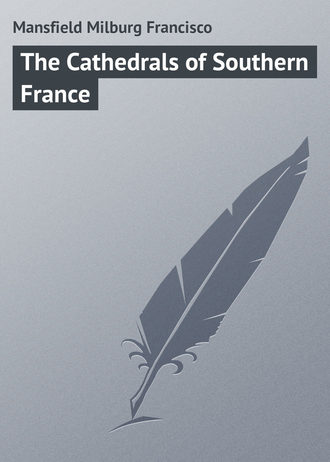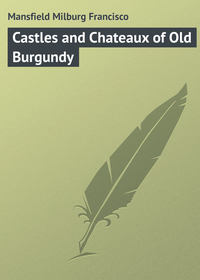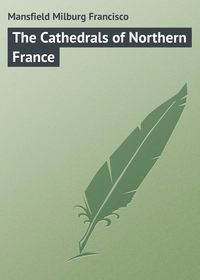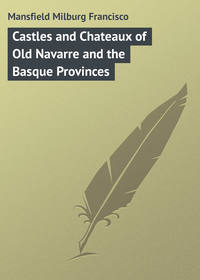 полная версия
полная версияThe Cathedrals of Southern France
For three centuries only was it endowed with diocesan dignity. Its last titulaire was Bishop Bossuet.
The fine Gothic church, which was so short-lived as a cathedral, is more worthy of admiration than many grander and more ancient.
It dates from the early sixteenth century, and shows all the distinct marks of its era; but it is a most interesting church nevertheless, and is possessed of a fine unworldly cloister, which as much as many another – more famous or more magnificent – must have been conducive to inspired meditation.
The portal rises to a considerable height of elegance, but the façade is otherwise austere.
In the interior, a choir-screen in cut stone is the chief artistic treasure. The sacristy is a finely decorated and beautifully proportioned room.
In the choir is a series of red brick or terra-cotta stalls of poor design and of no artistic value whatever.
The ancient residence of the bishops is now the Hôtel de Ville, and is a good example of late Gothic domestic architecture. It is decidedly the architectural pièce de resistance of the town.
IX
CATHÉDRALE DE MONTAUBAN
Montauban, the location of an ancient abbey, was created a bishopric, in the Province of Toulouse, in 1317, under Bertrand du Puy. It was a suffragan of the see of Toulouse after that city had been made an archbishopric in the same year, a rank it virtually holds to-day, though the mother-see is now known by the double vocable of Toulouse-Narbonne.
Montauban is in many ways a remarkable little city; remarkable for its tidy picturesqueness, for its admirable situation, for the added attraction of the river Tarn, which rushes tumblingly past its quais on its way from the Gorges to the Garonne; in short, Montauban is a most fascinating centre of a life and activity, not so modern that it jars, nor yet so mediæval that it is uncomfortably squalid.
The lover of architecture will interest himself far more in the thirteenth-century bridge of bricks which crosses the Tarn on seven ogival arches, than he will in the painfully ordinary and unworthy cathedral, which is a combination of most of the undesirable features of Renaissance church-building.
The façade is, moreover, set about with a series of enormous sculptured effigies perched indiscriminately wherever it would appear that a foothold presented itself. There are still a few unoccupied niches and cornices, which some day may yet be peopled with other figures as gaunt.
Two ungraceful towers flank a classical portico, one of which is possessed of the usual ludicrous clock-face.
The interior, with its unusual flood of light from the windows of the clerestory, is cold and bare. Its imposed pilasters and heavy cornices are little in keeping with the true conception of Christian architecture, and its great height of nave – some eighty odd feet – lends a further chilliness to one's already lukewarm appreciation.
The one artistic detail of Montauban's cathedral is the fine painting by Ingres (1781-1867) to be seen in the sacristy, if by any chance you can find the sacristan – which is doubtful. It is one of this artist's most celebrated paintings, and is commonly referred to as "The Vow of Louis XIII."
X
ST. ETIENNE DE CAHORS
St. Genulphe was the first bishop of Cahors, in the fourth century. The diocese was then, as now, a suffragan of Albi. The cathedral of St. Etienne was consecrated in 1119, but has since – and many times – been rebuilt and restored.
This church is but one of the many of its class, built in Aquitaine at this period, which employed the cupola as a distinct feature. It shares this attribute in common with the cathedrals at Poitiers, Périgueux, and Angoulême, and the great churches of Solignac, Fontevrault, and Souillac, and is commonly supposed to be an importation or adaptation of the domes of St. Marc's at Venice.
A distinct feature of this development is that, while transepts may or may not be wanting, the structures are nearly always without side aisles.
What manner of architecture this style may presume to be is impossible to discuss here, but it is manifestly not Byzantine pur-sang, as most guide-books would have the tourist believe.
Although much mutilated in many of its accessories and details, the cathedral at Cahors fairly illustrates its original plan.
There are no transepts, and the nave is wide and short, its area being entirely roofed by the two circular cupolas, each perhaps fifty feet in diameter. In height these two details depart from the true hemisphere, as has always been usual in dome construction. There were discovered, as late as 1890, in this church, many mural paintings of great interest. Of the greatest importance was that in the westerly cupola, which presents an entire composition, drawn in black and colour.
The cupola is perhaps forty feet in diameter, and is divided by the decorations into eight sectors. The principal features of this remarkable decoration are the figures of eight of the prophets, David, Daniel, Jeremiah, Jonah, Ezra, Isaiah, Ezekiel, and Habakkuk, each a dozen or more feet in height.
Taken as a whole, in spite of their recent discovery, these elaborate decorations are supposed to have been undertaken by or under the direction of the bishops who held the see from 1280 to 1324; most likely under Hugo Geraldi (1312-16), the friend of Pope Clement V. and of the King of France. This churchman was burned to death at Avignon, and the see was afterward administered by procuration by Guillaume de Labroa (1316-1324), who lived at Avignon.
It is then permissible to think that these wall-paintings of the cathedral at Cahors are perhaps unique in France. Including its sustaining wall, one of the cupolas rises to a height of eighty-two feet, and the other to one hundred and five feet.
The north portal is richly sculptured; and the choir, with its fifteenth-century ogival chapels, has been rebuilt from the original work of 1285.
The interior, since the recently discovered frescoes of the cupolas, presents an exceedingly rich appearance, though there are actually few decorative constructive elements.
The apse of the choir is naturally pointed, as its era would indicate, and its chapels are ornamented with frescoes of the time of Louis XII.; neither very good nor very bad, but in no way comparable to the decorations of the cupolas.
The only monument of note in the interior is the tomb of Bishop Alain de Solminiac (seventeenth century).
The paintings of the choir are supposed to date from 1315, which certainly places them at a very early date. A doorway in the right of the nave gives on the fifteenth-century cloister, which, though fragmentary, must at one time have been a very satisfactory example. The ancient episcopal palace is now the prefecture. The bishop originally bore the provisional title of Count of Cahors, and was entitled to wear a sword and gauntlets, and it is recorded that he was received, upon his accession to the diocese, by the Vicomte de Sessac, who, attired in a grotesque garb, conducted him to his palace amid a ceremony which to-day would be accounted as buffoonery pure and simple. From the accounts of this ceremony, it could not have been very dignified or inspiring.
The history of Cahors abounds in romantic incident, and its capture by Henry of Navarre in 1580 was a brilliant exploit.
Cahors was the birthplace of one of the French Popes of Avignon, John XXII. (who is buried in Notre Dame des Doms at Avignon).
XI
ST. CAPRAIS D'AGEN
Agen, with Cahors, Tulle, Limoges, Périgueux, Angoulême, and Poitiers, are, in a way, in a class of themselves with respect to their cathedrals. They have not favoured aggrandizement, or even restoration to the extent of mitigating the sentiment which will always surround a really ancient fabric.
The cathedral at Bordeaux came strongly under the Gothic spell; so did that at Clermont-Ferrand, and St. Nazaire, in the Cité de Carcassonne. But those before-mentioned did not, to any appreciable extent, come under the influence of the new style affected by the architects of the Isle of France during the times of Philippe-Auguste (d. 1223).
At the death of Philippe le Bel (1314), the royal domain was considerably extended, and the cathedrals at Montpellier, Carcassonne, and Narbonne succumbed and took on Gothic features.
The diocese of Agen was founded in the fourth century as a suffragan of Bordeaux. Its first bishop was St. Phérade. To-day the diocese is still under the parent jurisdiction of Bordeaux, and the see comprises the department of Lot-et-Garonne.
A former cathedral church – St. Etienne – was destroyed at the Revolution.
The Romanesque cathedral of St. Caprais dates, as to its apses and transepts, from the eleventh century.
Its size is not commonly accredited great, but for a fact its nave is over fifty-five feet in width; greater than Chartres, and nearly as great as Amiens in the north.
This is a comparison which will show how futile it is not to take into consideration the peers, compeers, or contemporaries of architectural types when striving to impress its salient features upon one's senses.
This immense vault is covered with a series of cupolas of a modified form which finally take the feature of the early development of the ogival arch. This, then, ranks as one of the early transitions between barrel-vaulted and domed roofs, and the Gothic arched vaulting which became so common in the century following.
As to the general ground-plan, the area is not great. Its Romanesque nave is stunted in length, if not in width, and the transepts are equally contracted. The choir is semicircular, and the general effect is that of a tri-apsed church, seldom seen beyond the immediate neighbourhood of the Rhine valley.
The interior effect is considerably marred by the modern mural frescoes by Bézard, after a supposed old manner. The combination of colour can only be described as polychromatic, and the effect is not good.
There are a series of Roman capitals in the nave, which are of more decided artistic worth and interest than any other distinct feature.
At the side of the cathedral is the Chapelle des Innocents, the ancient chapter-house of St. Caprais, now used as the chapel of the college. Its façade has some remarkable sculptures, and its interior attractions of curiously carved capitals and some tombs – supposed to date from the first years of the Christian era – are of as great interest as any of the specific features of the cathedral proper.
XII
STE. MARIE D'AUCH
The first bishop of Auch was Citerius, in the fourth century. Subsequently the Province d'Auch became the see of an archbishop, who was Primate of Aquitaine. This came to pass when the office was abolished or transferred from Eauze in the eighth century. The diocese is thus established in antiquity, and endures to-day with suffragans at Aire, Tarbes, and Bayonne.
The cathedral of Ste. Marie d'Auch is not of itself an ancient structure, dating only from the late fifteenth century. Its choir, however, ranks among the most celebrated in the Gothic style in all Europe, and the entire edifice is usually accorded as being the most thoroughly characteristic (though varied as to the excellence of its details) church of the Midi of France, though built at a time when the ogival style was projecting its last rays of glory over the land.
In its general plan it is of generous though not majestic proportions, and is rich and aspiring in its details throughout.
An ancient altar in this present church is supposed to have come from the humble basilica which was erected here by St. Taurin, bishop of Eauze, soon after the foundation of the see. If this is so, it is certainly of great antiquity, and is exceedingly valuable as the record of an art expression of that early day.
Taurin II., in 845, rebuilt a former church, which stood on the site of the present cathedral; but, its dimensions not proving great enough for the needs of the congregation, St. Austinde, in 1048, built a much larger church, which was consecrated early in the twelfth century.
Various other structures were undertaken, some completed only in part and others to the full; but it was not until 1548 that the present Ste. Marie was actually consecrated by Jean Dumas.
"This gorgeous ceremony," says the Abbé Bourassé, "was accomplished amid great pomp on the anniversary day of the dedication of the eleventh-century basilica on the same site."
In 1597 further additions were made to the vaulting, and the fine choir glass added. Soon after this time, the glass of the nave chapels was put into place, being the gift of Dominique de Vic. The final building operations – as might be expected – show just the least suspicion of debasement. This quality is to be remarked in the choir-screen, the porch and towers, and in the balustrades of the chapels, to say nothing of the organ supports.
The west front is, in part, as late as the seventeenth century.
In this façade there is an elaborately traceried rose window, indicating in its painted glass a "Glory of Angels." It is not a great work, as these chief decorative features of French mediæval architecture go, but is highly ornate by reason of its florid tracery, and dates, moreover, from that period when the really great accomplishment of designing in painted glass was approaching its maturity.
If any feature of remark exists to excite undue criticism, it is that of a certain incongruity or mixture of style, which, while not widely separated in point of time, has great variation as to excellence.
In spite of this there is, in the general ensemble, an imposing picturesqueness to which distance lends the proverbial degree of enchantment.
The warm mouse-coloured cathedral and its archbishop's palace, when seen in conjunction with the modern ornamental gardens and escalier at the rear, produces an effect more nearly akin to an Italian composition than anything of a like nature in France.
It is an ensemble most interesting and pleasing, but as a worthy artistic effort it does perhaps fall short of the ideal.
The westerly towers are curious heavy works after the "French Classical" manner in vogue during the reign of Louis XIV. They are not beautiful of themselves, and quite unexpressive of the sanctity which should surround a great church.
The portal is richly decorated, and contains statues of St. Roche and St. Austinde. It has been called an "imitation of the portal of St. Peter's at Rome," but this is an opinion wholly unwarranted by a personal acquaintance therewith. The two bear no resemblance except that they are both very inferior to the magnificent Gothic portals of the north.
The interior embellishments are as mixed as to style, and of as varied worth, as those of the exterior.
The painted glass (by a Gascon artist, Arnaud de Moles, 1573) is usually reckoned as of great beauty. This it hardly is, though of great value and importance as showing the development of the art which produced it. The colour is rich, – which it seldom is in modern glass, – but the design is coarse and crude, a distinction that most modern glass has as well. Ergo, we have not advanced greatly in this art.
The chief feature of artistic merit is the series of one hundred and thirteen choir-stalls, richly and wonderfully carved in wood. If not the superior to any others in France, these remarkable examples of Renaissance woodwork are the equal of any, and demonstrate, once again, that it was in wood-carving, rather than sculptures in stone, that Renaissance art achieved its greatest success.
A distinct feature is the disposition made of the accessories of the fine choir. It is surrounded by an elaborate screen, surmounted by sculpture of a richness quite uncommon in any but the grander and more wealthy churches.
Under the reign of St. Louis many of the grand cathedrals and the larger monastic churches were grandly favoured with this accessory, notably at Amiens and Beauvais, at Burgos in Spain, and at Canterbury.
Here the elaborate screen was designed to protect the ranges of stalls and their canopied dossiers, and give a certain seclusion to the chapter and officiants.
Elsewhere – out of regard for the people it is to be presumed – this feature was in many known instances done away with, and the material of which it was constructed – often of great richness – made use of in chapels subsequently erected in the walls of the apside or in the side aisles of the nave. This is to be remarked at Rodez particularly, where the reërected clôture is still the show-piece of the cathedral.
The organ buffet is, as usual (in the minds of the local resident), a remarkably fine piece of cabinet-work and nothing more. One always qualifies this by venturing the opinion that no one ever really does admire these overpowering and ungainly accessories.
What triforium there is is squat and ugly, with ungraceful openings, and the high-altar is a modern work in the pseudo-classic style, quite unworthy as a work of art.
The five apsidal chapels are brilliant with coloured glass, but otherwise are not remarkable.
In spite of all incongruity, Ste. Marie d'Auch is one of those fascinating churches in and about which one loves to linger. It is hard to explain the reason for this, except that its environment provides the atmosphere which is the one necessary ingredient to a full realization of the appealing qualities of a stately church.
The archiepiscopal palace adjoins the cathedral in the rear, and has a noble donjon of the fourteenth century. Its career of the past must have been quite uneventful, as history records no very bloody or riotous events which have taken place within or before its walls.
Fénelon was a student at the College of Auch, and his statue adorns the Promenade du Fossé.
XIII
ST. ETIENNE DE TOULOUSE
The provincialism of Toulouse has been the theme of many a French writer of ability, – offensively provincial, it would seem from a consensus of these written opinions.
"Life and movement in abundance, but what a life!" … "The native is saved from coarseness by his birth, but after a quarter of an hour the substratum shows itself." … "The working girl is graceful and has the vivacity of a bird, but there is nothing in her cackle." … "How much more beautiful are the stars that mirror themselves in the gutter of the Rue du Bac." … "There is a yelp in the accents of the people of the town."
Contrariwise we may learn also that "the water is fine," "the quays are fine," and "fine large buildings glow in the setting sun in bright and softened hues," and "in the far distance lies the chain of the Pyrenees, like a white bed of watery clouds," and "the river, dressed always in smiling verdure, gracefully skirts the city."
These pessimistic and optimistic views of others found the contributors to this book in somewhat of a quandary as to the manner of mood and spirit in which they should approach this provincial capital.
They had heard marvels of its Romanesque church of St. Saturnin, perhaps the most perfect and elaborate of any of its kind in all France; of the curious amalgamated edifice, now the cathedral of St. Etienne, wherein two distinct church bodies are joined by an unseemly ligature; of the church of the Jacobins; and of the "seventy-seven religious establishments" enumerated by Taine.
All these, or less, were enough to induce one to cast suspicion aside and descend upon the city with an open mind.
Two things one must admit: Toulouse does somewhat approach the gaiety of a capital, and it is provincial.
Its list of attractions for the visitor is great, and its churches numerous and splendid, so why carp at the "ape-like manners" of the corner loafers, who, when all is said, are vastly less in number here than in many a northern centre of population.
The Musée is charming, both as to the disposition of its parts and its contents. It was once a convent, and has a square courtyard or promenade surrounded by an arcade. The courtyard is set about with green shrubs, and a lofty brick tower, pierced with little arched windows and mullioned with tiny columns, rises skyward in true conventual fashion.
Altogether the Musée, in the attractiveness of its fabric and the size and importance of its collections, must rank, for interest to the tourist, at the very head of those outside Paris itself.
As for the churches, there are many, the three greatest of which are the cathedral of St. Etienne, St. Saturnin, and the Église des Jacobins; in all is to be observed the universal application or adoption of des matériaux du pays– bricks.
In the cathedral tower, and in that of the Église des Jacobins, a Gothic scheme is worked out in these warm-toned bricks, and forms, in contrast with the usual execution of a Gothic design, a most extraordinary effect; not wholly to the detriment of the style, but certainly not in keeping with the original conception and development of "pointed" architecture.
In 1863 Viollet-le-Duc thoroughly and creditably restored St. Saturnin at great expense, and by this treatment it remains to-day as the most perfectly preserved work extant of its class.
It is vast, curious, and in a rather mixed style, though thoroughly Latin in motive.
It is on the border-line of two styles; of the Italian, with respect to the full semicircular arches and vaulting of the nave and aisles; the square pillars destitute of all ornament, except another column standing out in flat relief – an intimation of the quiet and placid force of their functions.
With the transition comes a change in the flowered capitals, from the acanthus to tracery and grotesque animals.
There are five domes covering the five aisles, each with a semicircular vault. The walls, with their infrequent windows, are very thick.
The delightful belfry – of five octagonal stages – which rises from the crossing of the transepts, presents, from the outside, a fine and imposing arrangement. So, too, the chapelled choir, with its apse of rounded vaults rising in imposing tiers. This fine church is in direct descent from the Roman manner; built and developed as a simple idea, and, like all antique and classical work, – approaching purity, – is a living thing, in spite of the fact that it depicts the sentiment of a dead and gone past.
It might not be so successfully duplicated to-day, but, considering that St. Saturnin dates from the eleventh century, its commencement was sufficiently in the remote past to allow of its having been promulgated under a direct and vigorous Roman influence.
The brick construction of St. Saturnin and of the cathedral is not of that justly admired quality seen in the ancient Convent of the Jacobins, which dates from the thirteenth century. Here is made perhaps the most beautiful use of this style of mediæval building. It is earlier than the Pont de Montauban, the churches at Moissac or Lombez, and even the cathedral at Albi, but much later than the true Romanesque brickwork, which alternated rows of brick with other materials.
The builders of Gallo-Romain and Merovingian times favoured this earlier method, but work in this style is seldom met with of a later date than the ninth century.
The Église of St. Saturnin shows, in parts, brickwork of a century earlier than the Église des Jacobins, but, as before said, it is not so beautiful.
When the Renaissance came to deal with brique, it did not do so badly. Certainly the domestic and civil establishments of Touraine in this style – to particularize only one section – are very beautiful. Why the revival was productive of so much thorough badness when it dealt with stone is one of the things which the expert has not as yet attempted to explain; at least, not convincingly.
The contrasting blend of the northern and southern motive in the hybrid cathedral at Toulouse will not remain unnoticed for long after the first sensation of surprise at its curious ground-plan passes off.
Here are seen a flamboyant northern choir and aisles in strange juxtaposition with a thirteenth-century single vaulted nave, after the purely indigenous southern manner.
This nave nearly equals in immensity those in the cathedrals of Albi and Bordeaux. It has the great span of sixty-two feet, necessitating the employment of huge buttresses, which would be remarkable anywhere, in order to take the thrust. The unobstructed flooring of this splendid nave lends an added dignity of vastness. Near the vaulted roof are the only apertures in the walls. Windows, as one knows them elsewhere, are practically absent.









